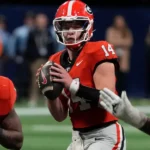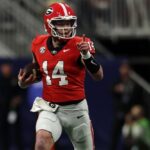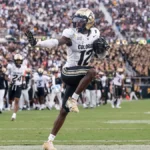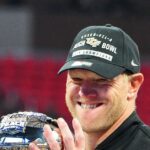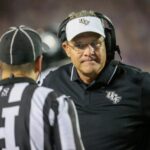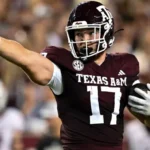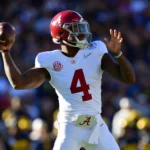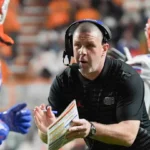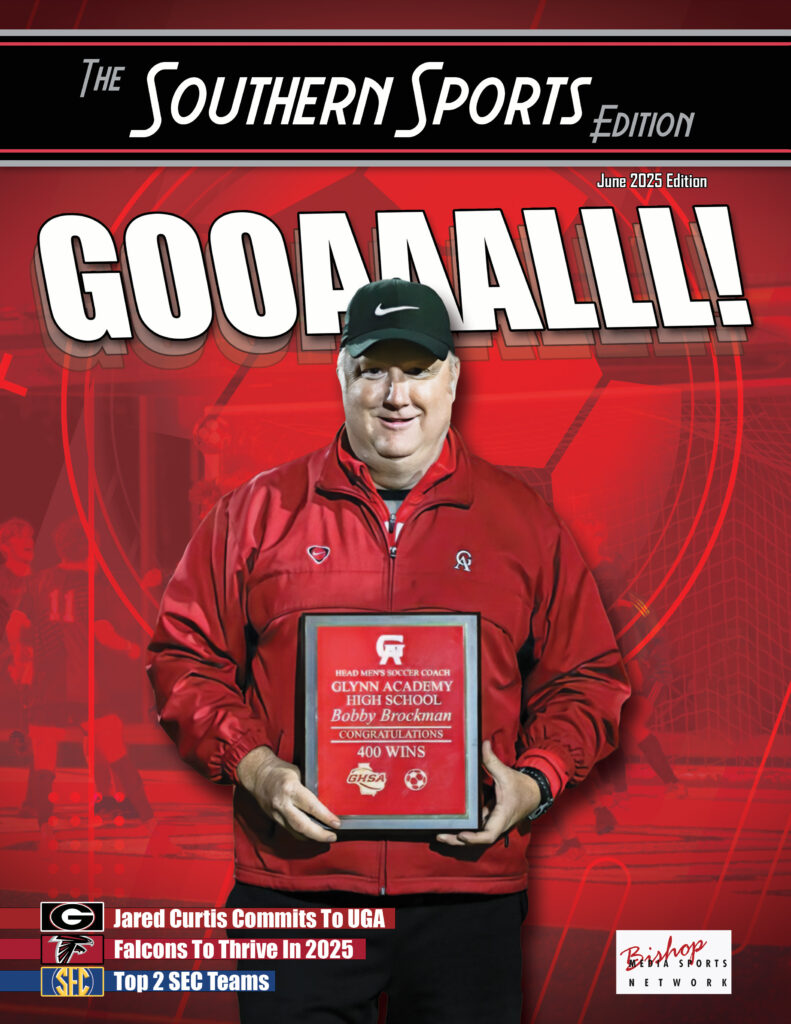Robert Craft
New Tricks Needed?
 By: Robert Craft
By: Robert Craft
TheSouthernSportsEdition.com news services
The signs were always there. The Alabama game. The Ole Miss game. Even plenty of victories: Kentucky, Georgia Tech, and the SEC Championship Game.
It all left everyone, including those within the Georgia football program, questioning if this was a group that actually would keep the legacy going to another championship.
We got that answer in the College Football Playoff. It was definitive. Georgia was not the best team in the country this year and they deserved their fate.
Now it leads to the next mystery: Was this game, and rocky season a kick in the butt to the program? Was this season a message that Georgia’s not the elite it was two years ago?
Does leadership need to change goals and make moves to avoid slipping further?
Although Georgia was ultimately still the SEC champion, they lost in the College Football Playoff quarterfinals when they were down to their backup quarterback.
Kirby Smart said some curious things after the loss to Notre Dame. Let’s start with his post-mortem on the season, which he called “Easily the toughest of my tenure.” That may be a bit of recency bias.
The truth reared its ugly face at The Bulldogs, and it said: Get better as a football program. Let Kirby’s above words sit and remember people- it’s not a second-year coach trying to get his program to another level, but the ninth-year coach of a team that won two of the previous three national titles.
Maybe on some level Kirby Smart mirrors his mentor Nick Saban with the mentality of always trying to improve, even when on top. Or maybe this year’s team is a reflection that this program isn’t on top right now.
There’s no clear answer. You can argue that transfer rules and paying players have changed the game.
The Big Ten and Notre Dame having three of the four semifinalists feed into that argument. But the 2022 season wasn’t that long ago, right? It’s not like this was a crashing disappointment for the Dawgs: They’re 4-1 against teams that made the Playoffs, the only one they lost was in the Playoffs.
There was just something missing, and Smart’s job is to figure out what that was, and to what extent does this team need to change.
Now for some apparent good news: Gunner Stockton looks like a viable starter for 2025-26. His pocket presence needs to improve, but that should grow with experience.
The underrated gap between Carson Beck and Stockton, in a start of this magnitude, may have been game management and making checks at the line, which Stockton acknowledged.
But if it is Stockton, the coaches need to acquire help around them. QBs and Coaches need receivers who won’t drop the ball. Georgia was burned during this portal window by receivers unsure of the identity or throwing ability of Georgia’s quarterback next season.
Maybe Stockton’s play helps convince recruits and transfers.
Let’s be clear. There is risk in overstating what happened in this game. Georgia outgained the Irish and averaged more yards. They reached the red zone more often. It’s not like this was a domination. Georgia belonged on the same field, but Georgia should be the more mature program in the building; all evidence says they were.
Instead, Georgia committed the game’s only two turnovers, gave up a 98-yard kickoff return because of missed tackles, and coach Smart made risks that backfired.
Looking back, much of Georgia’s problem was being outplayed by Notre Dame, especially in the second half, when UGA approached the cusp of another epic comeback and failed: The defense made a big fourth-down stop, handing the offense the ball at midfield. A 10-point game, plenty of time left, momentum at Georgia’s back. But the Bulldogs couldn’t capitalize, with go-nowhere plays on third-and-3 and fourth-and-2.
That was yet another mystery about this team. Stockton, whose arm was the question coming in, passed for 234 yards and looked pretty good for a new starter. Georgia just couldn’t run the ball, despite Notre Dame being without its best defensive player, lineman Rylie Mills. The Dawgs also did not protect well, yielding four sacks.
The offense will remain the focus. The defense can reload by retaining the talented youngsters who understudied this year. This Bulldog team will still be young, and this year’s inconsistent play showed that Georgia doesn’t have a birthright to elite defenses in today’s College Football Landscape.
Georgia isn’t automatically elite just because of rings in 2021 and 2022. They aren’t automatically elite as long as Smart is coach, he is starting to lose.
Although optimism still reigned in a losing locker room, do they deserve optimism with this result?
What did this loss mean for the program? Was it a hit to the ego?
Gunner?
 By: Robert Craft
By: Robert Craft
TheSouthernSportsEdition.com news services
How well Gunner Stockton will perform is still unclear.
As the world finds out about him off the field, Stockton’s a Georgia folk hero, his bona fide attributes are being filled in: his small-town roots, how he got his name, the fact he drives a 1984 Ford pickup. Stockton keeps four or five cows back home in Rabun County, which has become a running joke with some of his Georgia teammates.
There is no known correlation between bovine ownership and quarterback ability, and in less than a week, Georgia faces off against Notre Dame in the College Football Playoff quarterfinals.
Here are a few football-centric takeaways from Saturday, the day before Georgia leaves for New Orleans. After offensive coordinator Mike Bobo and four of his players met with members of the media.
Georgia guard Tate Ratledge forgot something at the team facility one night this week, and when he went back to get it at 10 p.m., he saw Stockton still there, watching film.
That wasn’t that unusual, according to Delp, who said Stockton watched film for four to five hours after practices in the regular season, not knowing if he would even play as the No. 2 quarterback.
Bobo said he could tell Stockton “took to heart” that he needed to prepare each week like a starter. That helped him seamlessly replace Carson Beck in the second half of the SEC Championship Game by leading a touchdown drive right away.
Stockton possessed a game plan focused on Beck’s pocket-passing skills and integrated into UGA’s high-performing offense seamlessly.
The extra time to adjust and prepare should be a big help for the offense. Before Georgia knew they would play Notre Dame, Georgia’s “back to basics” approach during the first week of practice kept Stockton in more situational drills: two-minute, third-down and red zone.
It helped Stockton lead the offense, rather than serving as the understudy or scout-team veteran.
“Now I can tell he has full control of this huddle,” Ratledge said.
That said, the spark was already there when Stockton came in during the SEC Championship Game. The past few weeks of practice seemed to have cemented it.
“Just seeing the way he’s carried himself and done everything the right way in his prior years leading up to this moment, Gunner’s just a guy you want to block for,” Ratledge said.
“He’s just a great guy, plays with a lot of emotion, brings everybody with him, and now he has the whole team behind him, ready to roll.”
The offense hasn’t had a sterling year: Georgia ranks 30th in scoring and 42nd in yards per play. But four of its games have been against defenses ranked in the top 10 nationally, with two others in the top 20.
This is Bobo’s second year back as the coordinator. When he met the media this time in 2023, it was after a better statistical year, but the team didn’t have a chance at a championship. This time, Bobo still has a chance to set the narrative.
Georgia has two new tailback injuries: Roderick Robinson and Branson Robinson are both expected to miss the rest of the Playoff with unspecified injuries sustained during practice.
That ends injury-riddled seasons for both players and removes the team’s most physical runners.
It hasn’t been a great rushing season anyway, as Bobo acknowledged. Georgia is only 11th in the SEC in rushing yards per attempt and 15th in total rushing yards per game.
Georgia was in the top three the previous three seasons and was once known as Tailback U., including during Bobo’s first stint as offensive coordinator.
The offensive line is pretty much in full health now. Etienne is, too, and with Nate Frazier, Georgia has two dynamic options out of the backfield, while Cash Jones is a veteran blocker and pass catcher. With Stockton at quarterback, a better running game is needed against Notre Dame.
Play Defense and run the ball are keys to Georgia’s victory.
Georgia 23 Notre Dame 13.
Strike The Pose
 By: Robert Craft
By: Robert Craft
TheSouthernSportsEdition.com news services
After winning the Heisman Trophy, Colorado’s Travis Hunter hugged his fiancée and then his mom.
When he got to Buffaloes’ coach Deion Sanders, the hug lasted a little longer.
He even went back in for another, putting his head on Sanders’ shoulder, and you could hear Hunter getting choked up.
Hunter thanked Coach Prime for changing his life, but the same can be said the other way around. Hunter is Sanders’ proof of concept.
Travis Hunter’s rise to stardom, fulfilling the promise of his five-star potential while playing full-time on both offense and defense, is Sanders’ most significant accomplishment as a college football coach. Hunter is the example Sanders can hold up to every other blue-chip recruit in the country.
More importantly, Hunter’s spectacular season should serve as an example to all those blue-chippers pondering where to go to school: Those coaches need you more than you need them. Don’t be afraid to chart your own path.
“I wanted to be different,” said Hunter, who also won the Biletnikoff Award as the nation’s best receiver and the Bednarik Award as the best defender. “So, you know me, being different makes me feel more comfortable than doing the norm.”
Coaches sell players on their ability to get guys to the NFL all the time. The numbers suggest the Alabamas, Georgias and Ohio States are better than most at developing NFL players.
The reality, though, is what really sets those programs apart is their ability to recruit more players with NFL potential.
Hunter, a Florida native, could have gone to any school in the country after playing high school ball in Georgia.
He was committed to Florida State, but at the last moment flipped to Jackson State, a historically Black university in the FCS.
It was truly a road not taken. In the modern era of recruiting rankings, where the best of the best are identified and sorted earlier and better than ever, no player with Hunter’s pedigree had ever chosen to play in Division I’s second tier instead of the top.
For Sanders, it was the ultimate recruiting coup, swiping Hunter from his old school in Tallahassee.
Sanders sold something bigger than just getting Hunter to the league. During ESPN’s Heisman show, Sanders said he encouraged Hunter to be “unapologetically” himself.
Hunter’s mom, Ferrante Edmonds, called her son Travis a little goofy. He wears onesies. He said he never really listened to music until his fiancé opened his ears to Lil Wayne (who showed up on Saturday to congratulate Hunter).
Hunter’s favorite thing besides football is fishing. He said he spent his Friday night in New York watching fishing videos to chill out.
How many coaches would have given Hunter the opportunity to play both ways to the extent of Sanders, who probably could have done the same when he played for Bobby Bowden at Florida State, did with Hunter?
Hunter, along with Sanders’ son and star quarterback, Shedeur, will play their last games for No. 23 Colorado on Dec. 28 in the Alamo Bowl against No. 17 BYU.
Sanders has been adamant about his intent to remain Colorado’s head coach when his sons (he includes Hunter with Shedeur and defensive back Shilo) move on.
Hunter is unicorn of a football player, the legacy he leaves behind hopefully encourages more players to take the road less traveled.
Gator Bait
 By: Robert Craft
By: Robert Craft
TheSouthernSportsEdition.com news services
A year after they failed to achieve bowl eligibility, The Florida Gators (7-5; 4-4 SEC) secured its return to postseason play with a spot in the Gasparilla Bowl on December 20, where it will face Tulane (9-4; 7-1 AAC).
It marks the Gators’ second bowl appearance in three years under head coach Billy Napier and their 22nd since the New Millenium (That’s the year 2000 for our younger readers).
Florida is 11-10 in postseason games since the turn of the century, excluding SEC championship games.
“We just have access to the players a lot more than we used to in the old days,” Napier said of securing a bowl berth. “All spring, all summer you can be on the field. It’s a little bit more of a reward for the players. It’s another opportunity to create momentum for the program. A lot of our redshirt players that will be able to play in the game which will be big.”
The Gators enjoyed their best season of the Napier era in 2024, winning seven total games and four against SEC foes, both program highs under his current leadership.
Florida’s success was the byproduct of an impressive run to end the regular season, five wins in their final eight games and each of their last three, including back-to-back wins over then-No. 21 LSU and then-No. 9 Ole Miss.
This was the first time the Gators had recorded multiple ranked wins in the same season under Napier’s watch.
Napier and his players said their bye week in late September was the catalyst for their marked improvement.
“I walked off that field and said, ‘That’s the best practice I’ve been associated with in 20 years of college football,'” Napier said. “So, at that point, I’m like, ‘We’ve got to figure this out.'”
He added that the Gators’ Oct. 12 loss to Tennessee also provided a motivational boost.
“I think Tennessee was a turning point,” Napier said. “I think in that locker room after the game, that was when it was like, okay, we can do this, and I think obviously Kentucky, another open date, what we experienced in Jacksonville. I just think hope is powerful, man. Just proud of these guys, man.”
While Florida’s 2024 campaign was ultimately successful enough to buy Napier a fourth season at the helm, things looked quite bleak for it at the outset.
The Gators suffered their worst home-opening defeat in program history when they lost 41-17 to Miami on Aug. 31 and endured a second blowout loss two weeks later at The Swamp against Texas A&M.
Looking back, Napier said those matchups bettered his team, too.
“Sometimes you’ve got to go through stuff,” he said. “They’re different because they went through that. They don’t really care what anybody thinks. They care what the people around them think. They care about doing their job and being accountable and being responsible to the people around them. I think what they’ve been through has forced them to do that, and I can say the same thing.”
The Gators could keep their hot streak alive in their bowl game with many of their key contributors likely to participate, including freshman quarterback DJ Lagway, junior center Jake Slaughter, freshman running back Jaden Baugh, junior edge rusher Tyreak Sapp and sophomore defensive back Bryce Thornton.
Florida is looking for its eighth win of its season for the first time since 2020. Did anyone predict this ending 5-6 weeks ago?
Who’s Next?
 By: Robert Craft
By: Robert Craft
TheSouthernSportsEdition.com news services
So how good is the UCF Head Coaching job? What names could get in the mix? Here is a breakdown of the job and the potential names to watch.
Jamey Chadwell (Liberty) is 57-17 as a full-time head coach, including a 21-4 run with the Flames.
The 47-year-old Tennessee native ran one of the most entertaining offenses in the country at Coastal Carolina, which seems like a good fit for UCF’s modern, up-tempo brand. Chadwell has never worked at a Power 4 program.
Scott Frost is beloved at UCF after going 13-0 in his second season. But he never had a winning record, with his 16-31 stint at Nebraska, and history suggests that these coaching sequels never live up to the standard of the original, and rarely go well.
G.J. Kinne (Texas State) was Malzahn’s co-offensive coordinator at UCF in 2021. The 36-year-old Texas native also fits the Knights’ identity.
Kinne led Incarnate Word to the FCS semifinals in 2021, and his 15-10 record with the Bobcats earned him a contract extension in November. Is changing jobs a viable option?
Joey Halzle (Tennessee OC) is another former UCF assistant; he spent two seasons under Heupel and followed him to the Vols.
The 38-year-old California native has had success as a quarterbacks coach, tutoring Hendon Hooker and Nico Iamaleava, among others.
Ryan Silverfield (Memphis) overcame a bumpy start to his tenure and is 20-5 over the past two seasons.
The former Mike Norvell assistant has Florida ties. The 44-year-old is from Jacksonville and spent two years with UCF as a graduate assistant. His offense has ranked in the top 25 in scoring in each of the past three years.
Barry Odom(UNLV) was in consideration the last time and had the Rebels in the Mountain West title game. But the former Missouri head coach has a defensive background, and UCF has a much stronger offensive identity.
Will Stein(Oregon OC) leads a top-20 offense for a national championship contender. He’s also the position coach for former UCF star Dillon Gabriel, a potential Heisman Trophy finalist.
A deep Playoff run could complicate the timing for the 35-year-old Kentucky native.
Charlie Weis Jr. (Ole Miss OC) is a future head coach, but is he ready for a Power 4 job at age 31? He has familiarity in the state with stints at South Florida and Florida Atlantic and briefly overlapped with Mohajir at Kansas (when Mohajir was an administrator and Weis Jr. was a manager on the football team coached by Weis Sr.).
JON SUMRALL (TULANE) will be one of the hottest coaching names on the carousel. In two seasons at Troy he won 23 games and led the Trojans to two straight Sun Belt titles.
At Tulane this season he led the Green Wave to the American Athletic Conference title game.
Sumrall is expected to be choosy if he decides to leave the Green Wave (he was once a defensive assistant there and wanted to return to New Orleans).
An opportunity to coach in a power conference with a team building to win might be hard to pass up.
In Conclusion: UCF is the fourth major program sitting in the center of one of the most talent-laden states in the country.
The Knights have a clear identity (modern, fast) to sell to recruits. They are new to the Power 4, and it’s fair to wonder if fans’ enormous expectations (buoyed by the undefeated season/national title from 2017) are attainable immediately.
Regardless, there’s great potential for eventual success in a Big 12 that lacks heavyweight, championship bound programs.
Gus Bus Leaves
 By: Robert Craft
By: Robert Craft
TheSouthernSportsEdition.com news services
Gus Malzahn is resigning after four seasons as the head coach at UCF.
He will become the offensive coordinator at Florida State University, multiple sources with knowledge of the hiring have confirmed.
Malzahn, 59, went 28-24 with the Knights. After two nine-win seasons in the AAC, UCF fell to 10-15 in its first two years in the Big 12.
UCF finished 4-8 in 2024, ending the season with a 28-14 loss at home to Utah.
Malzahn and Florida State coach Mike Norvell have known each other for almost 20 years. Malzahn was the offensive coordinator at Tulsa when he heard about Norvell through a friend.
Malzahn hired Norvell (then a graduate assistant at Central Arkansas) as a GA with the Golden Hurricanes before the 2007 season. Norvell rose the ranks after Malzahn left to become an assistant at Auburn.
Malzahn will be taking over a Florida State offense that heads into its season-finale against Florida, and they are ranked 131st nationally in both yards per game and points per game.
Malzahn is 105-62 in 13 seasons as an FBS head coach with one season at Arkansas State and eight at Auburn.
The Arkansas native went 68-35 at Auburn, with a BCS championship game appearance in 2013, his first season as head coach.
He never had a losing record there and went 3-5 against Nick Saban’s Alabama Crimson Tide teams in the Iron Bowl, but he was let go after the 2020 season, with the school paying a then-record $21.5 million buyout to get rid of him.
Malzahn was also a successful offensive coordinator in the SEC, first at Arkansas and then at Auburn, helping Cam Newton and the Tigers win a national title in 2010.
UCF athletic director Terry Mohajir rushed in as soon after Malzahn was let go by Auburn, a splashy move to replace Josh Heupel after he left for Tennessee.
Malzahn seemed invigorated by the new challenge. He bought into the branding and underlying idea that UCF was the future of college football as a growing program in the center of one of the nation’s biggest football states.
Malzahn’s 2024 recruiting class was the best in program history, finishing 39th in the 247Sports Composite.
His staff fended off one of Florida to sign defensive lineman John Walker, the nation’s No. 95 overall prospect and the top recruit in program history.
Even during two seasons in the AAC, UCF failed to meet the elevated expectations of a program that went to back-to-back New Year’s Six Bowls in 2017 and 2018 under Scott Frost and Heupel.
The Knights went 18-9 his first two seasons, losing the American title game in 2021 before beating Florida in the Gasparilla Bowl.
All three former AAC schools, including Houston and Cincinnati, have struggled to win since entering the Big 12.
UCF had the best first season by reaching a bowl game. But the Knights had one of the season’s biggest collapses when they blew a 28-point second-half lead to Baylor in their first Big 12 home game.
Year 2 was expected to bring solid results with Arkansas transfer KJ Jefferson, a promising match for Gus’s offense.
Instead, it brought a quarterback carousel ,a midseason firing of Defensive Coordinator Ted Roof, Malzahn handing off play-calling to offensive coordinator Tim Harris, and several close losses that could have flipped the season.
UCF issued the following statement: “We would like to thank coach Malzahn for his contributions to our football program over the past four seasons, including our transition into the Big 12 Conference. We appreciate his professionalism and dedication to our student-athletes throughout his tenure at UCF and wish he and his wife, Kristi, the very best in their future endeavors.”
Malzahn had three years left on a contract that would have paid him about $5.5 million annually.
Staying Alive
 By: Robert Craft
By: Robert Craft
TheSouthernSportsEdition.com news services
Which teams control their destiny to make the Playoff?
Right now, it feels there are about 20 of them, and it’s making for some great angst and drama.
Everyone from No. 1 Oregon (which is already in at this point) through No. 8 Miami (which would win the ACC) is safely in if they don’t lose another game.
Ditto these teams that will win their conference and an automatic berth if they win out: No. 13 SMU (ACC), No. 14 BYU (Big 12), No. 15 Texas A&M (SEC), No. 16 Colorado (Big 12) and No. 21 Arizona State (Big 12).
So, that’s 13. But let me address some of the ones I left out.
No. 9 Ole Miss and No. 10 Georgia , the final two at-large teams, are seemingly close but could get caught up in some weird SEC tiebreaker math.
If nothing else, Texas A&M winning the SEC and supplanting Texas as the highest-ranked SEC team would bump everyone else down a rung. Or either Ole Miss or Georgia makes the title game, loses and then drops too far to remain an at-large team. (This would be painfully dumb, but I wouldn’t rule it out.) But hey, at least No. 7 Alabama has some breathing room in that scenario.
I initially planned to put No. 12 Boise State in the group above but realized No. 19 Army could well pass the Broncos for the Group of 5 berth if the Black Knights beat Notre Dame, Tulane and remain undefeated.
And I don’t think it’s possible both would finish above an 11-2 Big 12 champ. Probably neither will. That’s why I’m comfortable including Arizona State in that pool.
So, it’s 13 that control their destiny and, by my count, 23 that still hold at least a glimmer of hope the 17 I mentioned- plus No. 11 Tennessee, No. 17 Clemson (can win the ACC), No. 18 a South Carolina (slim at-large hopes), No. 20 Tulane (G5), No. 22 Iowa State (can win the Big 12) and No. 24 UNLV (G5).
Twenty-three teams with a shot with three weeks to go. Last year at this same point, there were eight.
My question is should head-to-head play a factor?
Because head-to-head is not as simple as Team A beat Team B. Was the game close or a blowout? The latter is harder to overlook. Did Team B lose at home or on the road? Losing at home is less excusable.
And most importantly, in the context of their larger seasons, did this result fit with what the teams did the rest of the year, or was it wildly out of character? One game shouldn’t automatically void the other 11.
I was mildly surprised the committee held Texas’ Week 2 road win over Alabama last season so sacrosanct given it happened so early in the season, but it felt it couldn’t include the Tide in the final four without having the Horns one spot above them.
And now this season, you’re seeing it with the way it carefully ordered Alabama-Ole Miss-Georgia. (BYU/SMU, not so much.)
But I can think of one possibility that would be an absolute nightmare for the committee.
Say Notre Dame beats Army this week but loses to USC to finish 10-2. The Irish are out, right?
Except, what if Texas A&M beats Texas to advance to the SEC Championship Game, loses that game on a last-second field goal and finishes 10-3? Greg Sankey will lose his mind if the committee keeps the Aggies out because they played a 13th game but surely they cannot put 10-win A&M in and leave out 10-win Notre Dame that won in College Station, right? It’s the same scenario as Texas-Alabama last year.
Either both would be in or neither would be in.
Buckle up it’s gonna be an exciting last two weeks of college football. Let’s see what happens!
All Bark?
 By: Robert Craft
By: Robert Craft
TheSouthernSportsEdition.com news services
If anyone’s wondering how important Georgia’s showdown against Tennessee is on Saturday, let me tell you.
Win, and all is OK, full steam ahead to the College Football Playoffs and perhaps even a National Championship.
Lose, this season is set, but not in a good way.
It’s not ideal for any team to lose football games, but it happens. It’s much less ideal to try to clean up two viral messes from that loss. It’s even less ideal to field a question about whether to change quarterbacks.
The first viral moment: Carson Beck, starting and beleaguered quarterback, was spotted smiling on the bench as he spoke with backup quarterback Jaden Rashada during the fourth quarter of Georgia’s 28-10 loss to Ole Miss (UGA’s largest point margin loss in five years).
The visual was seized as a symbol of what’s wrong with Beck and perhaps the entire Bulldog football team.
The optics were poor and out of context: Harlen Rashada, Jaden’s father, posted, showing the moment before, Beck not smiling, Jaden Rashada telling him something that made him laugh.
Here the internet had birthed yet another out-of-context viral moment.
Beck’s on-field play has noticeably regressed. The easy excuse is he wasn’t focused during the offseason, between his Lambo and his personal life. Beck told me in the spring he wasn’t working any less, he was taking time to enjoy life after four years of hard work, which he certainly had earned.
We have seen many young athletes enjoy their life as a college student, and still thrive on the field.
It also feels invalid to attribute the offensive troubles to Beck’s leadership. He’s never been a rah-rah quarterback, and Stetson Bennett wasn’t either.
The difference might be the leaders around Beck. Nobody appears to have filled the void left by center Sedrick Van Pran. There isn’t an obvious alpha personality on the other side of the ball the way this year’s defense has Jalen Walker.
But the defense shouldn’t be absolved of blame, either. It came up huge in the wins over Texas and Clemson but also gave up big plays at Ole Miss, started soft against Alabama and has earned a reputation of inconsistency, ranking eighth in the SEC in defensive yards per play.
It’s not like a great defense is being wasted. A ton of world-class athletes on defense aren’t playing to their potential. Luckily for them, there’s still time. There’s still time for the whole team.
In the wide scope of this season, going 10-2 with this schedule is perfectly acceptable.
The focus then moves to how Georgia performs in the Playoff, where pressure still waits, but the minimum threshold of making the dance has been hit.
Missing the Playoff, meanwhile, would in the kindest interpretation mean that Georgia was a flawed team undone by a brutal schedule.
The harsher takeaway would be that the schedule exposed a team that isn’t very good and the program has work to do this offseason to get back to status.
Even then, perspective is needed. This is a program that has won two of the past three national championships, then fell short but still went 13-1. If anyone has earned leeway to slip its Georgia.
If any coach has shown he can adapt and make needed changes, it’s Smart. Panicky fans need to touch grass.
Georgia may feel a lot better after Saturday. Through these years of winning Smart has loved to say that “humility is a week away.” Well, humility is here, and so is the chance for redemption.
SEC Dominance
 By: Robert Craft
By: Robert Craft
TheSouthernSportsEdition.com news services
Kirby Smart wrapped up practice Tuesday at The University of Georgia. The College Football Playoff rankings just released, naturally interviewers asked Smart if the expanding field to 12 this year changed his curiosity.
“I could care less,” Smart said. “Because what is a quality win and a quality loss right now; they’ve been known to change their mind before it comes.”
The format may be different and the field may be bigger, but Georgia has experienced this before. Texas did last year. Tennessee did two years ago. Alabama and LSU have plenty of experience with it. At this point, everyone knows the deal by now.
Smart and SEC commissioner Greg Sankey may not love Georgia’s rank at third, behind two Big Ten teams, while the Bulldogs are second in the AP and coaches polls.
There are seven SEC teams in the top 25, by far the most of any conference (in second place: the Big Ten. With four). That’s an important note for a couple of reasons:
With four in the top 12 (Georgia, Texas, Tennessee, Alabama) and a few in striking distance (No. 14 Texas A&M, No. 15 LSU, No. 16 Ole Miss), this sets up more SEC teams to make the playoffs in the future.
Second, more SEC teams will have more chances for ranked wins, or their ranked losses might not seem as bad to the rankings.
Georgia bought itself a lot of room with its win at Texas, giving it a second ranked win, and its only loss came at Alabama. It would seem the Bulldogs need only get a split of the next two games at Ole Miss and Tennessee and they would be in. Even if UGA lost both games, they would have an argument.
Texas and Tennessee also have one loss but a little less leeway.
Texas is clearly in if they win out, although losing at Texas A&M in the regular-season finale would make things dicey.
The Longhorns don’t have a win over any team in the Top 25. Vanderbilt, ranked in the AP, didn’t make the CFP rankings.
Tennessee is all set if they win out because an 11-1 record with a win at Georgia is a strong argument.
If The Vols are competitive at Georgia and lose, 10-2 with two road losses but a win against Alabama may be enough to get it done. Of course, the regular-season finale at Vanderbilt isn’t a sure win.
Texas A&M, meanwhile, is not in the field right now — 14th — but the assignment seems straightforward: Win out, including the Texas game, and the Aggies are close enough to feel good about their chances.
Important caveat: winning out is no guarantee; it depends heavily on what happens elsewhere. As Smart pointed out, the committee is known to change their mind.
Alabama at LSU this week: The loser has a third loss, which puts its Playoff hopes to sleep, while the winner is in great shape. But is the loser truly done and the winner truly in?
Alabama would have three losses to ranked teams LSU, Tennessee and Vanderbilt, if it could sneak into the CFP Top 25 with one ranked win (Georgia) and some others that might check off as good.
LSU may need this win more. It has a loss to unranked USC and the other to Texas A&M. Their best win right now is against Ole Miss.
Then there’s Ole Miss, which is almost certainly done if it loses to Georgia this week. But if Ole Miss wins, that would give it something a ranked win and winning out would mean a 10-2 record.
Still, it has a home loss to Kentucky, and other than the Georgia game, there isn’t much impressive on the resume. So, Lane Kiffin’s team would seem at the mercy of the committee and things falling its way elsewhere.
There are so many important games left and too many data points left to draw any grand conclusions. Nobody from the SEC is definitely in yet, and seven teams still have a realistic shot.
That number figures to go down after this weekend. The question is whether it continues going down over the coming weeks or the SEC ends up with a half-dozen candidates for only so many spots.
Stars To Align?
 By: Robert Craft
By: Robert Craft
TheSouthernSportsEdition.com news services
Florida head coach Billy Napier probably didn’t save his job by drubbing Kentucky.
But maybe he did enough in a must-not-lose game to think maybe, just maybe, there’s maybe a path to a fourth season for Billy.
The beatdown provided a dose of optimism that Napier can coach a high caliber team in the future, if not this season.
Injuries to veteran starters Graham Mertz and Montrell Johnson meant Florida had to start true freshmen at quarterback (DJ Lagway) and running back (Jadan Baugh) for the first time in program history. That duo sparked the Gators’ best offensive performance in years.
Beating Kentucky is a baseline expectation at Florida. It used to be, at least; the Gators won 31 in a row before Mark Stoops snapped the streak in 2018.
Stoops won his first two against Napier. No Florida coach has lost three in a row to Kentucky in more than 70 years (Bob Woodruff, 1948-51). Napier, compared to his expectations, merely avoided ignominy with a win Saturday.
Besides, the real tests are still ahead. The 4-3 Gators were off last week before the daunting, season-ending stretch fans have been dreading for months: No. 2 Georgia in Jacksonville, at No. 5 Texas, home against No. 8 LSU and No. 18 Ole Miss and at rival FSU.
In Austin, TX, in front of a stadium-record 105,215 fans, Kirby Smart’s Dawgs (6-1, 4-1 SEC) unleashed the most havoc-wreaking defensive performance of the season in a 30-15 win.
It got so bad, so fast for Texas (6-1, 2-1 SEC), trailing 20-0 in the second quarter, that Steve Sarkisian briefly benched starting QB Quinn Ewers for, only to go back to Ewers after two series.
Neither QB had a chance, given the Horns offensive line had no answers for Georgia pass rushers Jason Walker (three sacks, four QB hurries), Mykel Williams(two sacks) and Damon Wilson (one strip-sack).
Georgia may well turn around and lay an egg against Florida, but they can afford it. Kirby Smart will not allow the Dawgs to be flat in Jacksonville.
The Dawgs open up as a 17 1/2 point Favorite against the Gators.
Florida hasn’t played a team as talented on the roster as Georgia. The Gators will need the stars to align to have a chance at the cocktail party.
If Billy Napier can pull off a miraculous victory over the heavily favored Dawgs, he may be able to save his job for one more season.
Georgia just has way way way too much talent for this game to even be close. Also, this game is personal for Kirby and Georgia starting quarterback Carson Beck.
To quote Clubber Lane from Rocky III my prediction is PAIN!
Georgia 47
Florida 20
